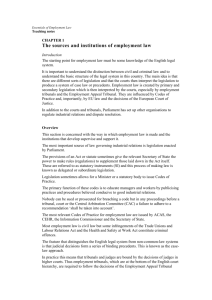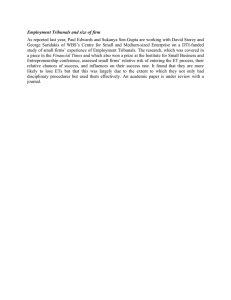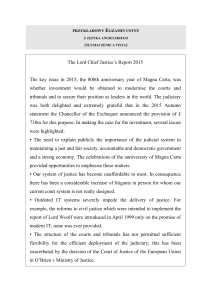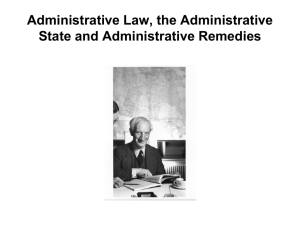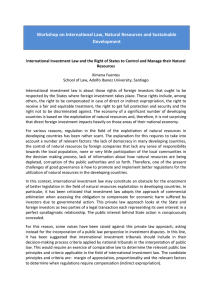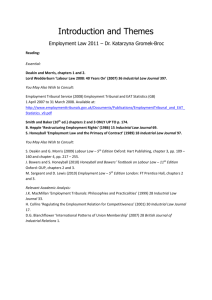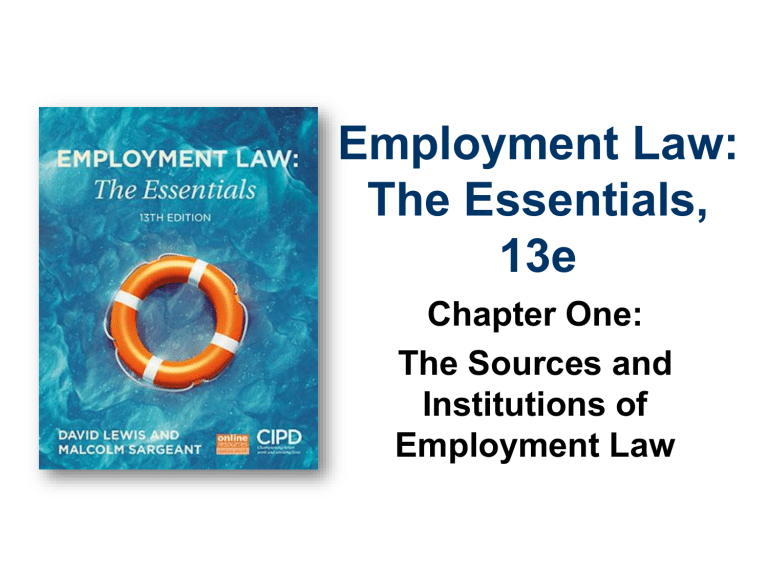
Employment Law: The Essentials, 13e Chapter One: The Sources and Institutions of Employment Law Overview • This section introduces the way in which employment law is made and the institutions that develop, supervise and enforce it. Civil and Criminal Law • It is important to understand the distinction between civil and criminal law and to have a basic idea of the structure of the legal system in this country. Primary and Secondary Legislation • Employment law is created by primary and secondary legislation which is then interpreted by the courts, especially by employment tribunals and the Employment Appeal Tribunal. Other Influences • Primary and secondary legislation are influenced by Codes of Practice and, importantly, by EU law and the decisions of the Court of Justice of the European Union. • In addition to the courts and tribunals, there are other organisations set up by Parliament to help with dispute resolution and to regulate industrial relations. Other Influences cont. • The most important source of law governing industrial relations is legislation enacted by Parliament. Subordinate Legislation • The provisions of an Act or statute sometimes give the relevant Secretary of State the power to make rules (regulations) to supplement those laid down in the Act itself. These are referred to as statutory instruments (SI), and this process of making law is known as delegated or subordinate legislation. Subordinate Legislation cont. • Legislation sometimes allows for a Minister or a statutory body to issue Codes of Practice. • Legislation sometimes allows for a Minister or a statutory body to issue Codes of Practice. • Although they are established under legislation, Codes of Practice are not themselves laws. Subordinate Legislation cont. • This means that breaching them is neither a civil nor a criminal offence. • Nobody can be sued or prosecuted for breaching a code – but in any proceedings before a tribunal, court or the Central Arbitration Committee (CAC) a failure to adhere to a recommendation ‘shall be taken into account’. Subordinate Legislation cont. • The most relevant Codes of Practice for employment law are issued by ACAS, the CEHR, the Information Commissioner and the Secretary of State. • Most employment law is civil law, but the Trade Unions and Labour Relations Act and the Health and Safety at Work Act provide criminal sanctions for wrong doing. Case Law • The feature which distinguishes the legal system in England and Wales from noncommon-law systems is that judicial decisions form a series of binding precedents. This is known as the case-law approach. • In practice this means that tribunals and judges are bound by the decisions of judges in higher courts. Case Law cont. • In practice this means that tribunals and judges are bound by the decisions of judges in higher courts. • Thus employment tribunals, which are at the bottom of the English court hierarchy, are required to follow the decisions of the Employment Appeal Tribunal (EAT or Appeal Tribunal), the Court of Appeal and the Supreme Court. Case Law cont. • Early cases in the Court of Justice of the European Union established the supremacy of community law over national law. • This means that tribunals and courts have an obligation to interpret national law so that it gives effect to EU law. Case Law cont. • National legislation should therefore be interpreted in a way that is consistent with the objects of the EU Treaty, the provisions of any relevant Directives and the rulings of the Court of Justice of the European Union. • European Union Directives are usually general statements of principle, and Member States are required to introduce their own legislation which transposes each Directive into national law. Case Law cont. • If the aims of a Directive have not been transposed correctly, citizens may rely on European laws which take precedence and are directly effective against the state or emanations of the state. Employment Tribunals • Employment tribunals sit at the base of the court hierarchy. They are specialist bodies whose decisions can be appealed against, on points of law, to the Employment Appeal Tribunal. • The Advisory, Conciliation and Arbitration Service was established to provide an alternative to litigation for the resolution of disputes. Employment Tribunals cont. • ACAS has the general duty of improving industrial relations and provides advice, individual and collective conciliation and arbitration services. • The Central Arbitration Committee deals with complaints about failure to disclose information for the purposes of collective bargaining. Employment Tribunals cont. • It also has an important role to play in the procedure for the statutory recognition of trade unions. • To benefit from the protection of the law, trade unions must be both independent and registered. • The Certification Officer maintains lists of employers’ associations and trade unions, and issues certificates of independence.
